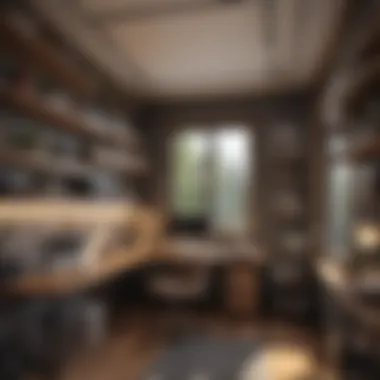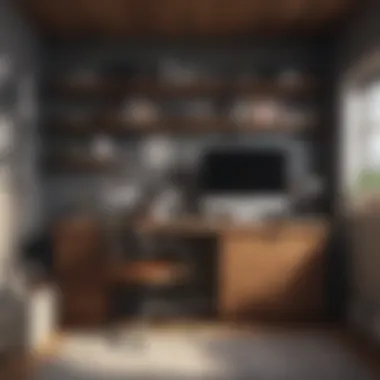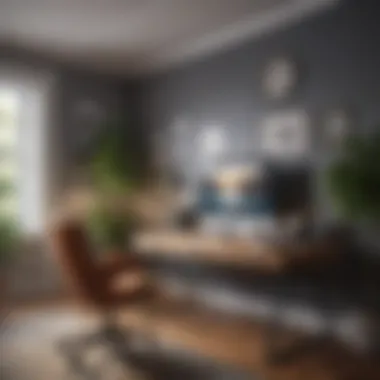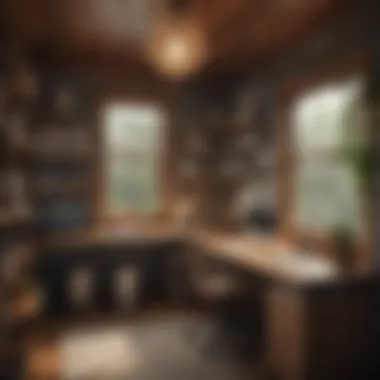Transforming Tiny Spaces into Productive Home Offices


Intro
As more folks opt for tiny homes, the need for a practical workspace becomes crucial. Turning a limited space into a multi-functional home office is no small feat, but it can be done with some careful planning and creativity. Whether you are a freelancer, a remote worker, or simply need some focused time for your personal projects, a tiny house offers unique challenges and opportunities.
This guide aims to walk you through the essential materials, step-by-step instructions, and technical aspects that will turn your tiny home into the office of your dreams. By focusing on efficient designs and optimized space use, we’ll help ensure your workspace allows for both productivity and comfort.
Materials:
Designing a home office that fits snugly into your tiny house requires thoughtful selection of materials. Here’s a list to get you started:
- Plywood Sheets: 4' x 8' sheets, at least three for desk and shelves.
- 2x4 Lumber: A bunch, around 10 pieces for framework and support.
- L-Brackets: About 20 for reinforcing joints.
- Corner Floater: 1 for sturdiness.
- Screws: 1.5" wood screws and 2" for various builds, around 100 total.
- Wood Glue: One bottle, for additional support.
- Varnish or Paint: Choose a hue that fits your vibe, roughly a quart.
- Fabric: About 2 yards, if adding cushions or a chair cover.
- Light Fixtures: One or two energy-efficient options to bright up the area.
- Power Strip: To accommodate all the tech, look for ones with surge protection.
DIY Steps:
Step-by-Step Process:
- Planning the Layout:
- Building the Desk:
- Creating Storage Solutions:
- Assembling the Office:
- Final Touches:
- Measure the space you're converting into an office. Make note of windows, doors, and outlets. Consider foot traffic and how you'll move within the space.
- Cut the plywood to the desired size for the desk. You might want a length of about 5 feet, depending on your layout.
- Use the 2x4 lumber to create a sturdy frame underneath. Attach L-brackets in each corner for added support.
- Build shelves using the same plywood, and mount them securely to the wall. Ensure they’re at a height that works for you.
- Place the desk against the wall and set up your chair. Ensure your computer setup is ergonomic.
- Paint or varnish the wood for aesthetic appeal. Add your chosen fabric for a personal touch, maybe on the chair or cushions.
Technical Aspects:
Tools necessary for the project include:
- Circular Saw for cutting plywood.
- Drill for drilling holes and driving screws.
- Level to ensure everything is straight.
- Measuring Tape
- Sandpaper for finishing edges.
Timing specifics:
- Set aside a couple of weekends. Most tasks can be completed in a day each, provided the materials are prepped.
DIY project Process:
Sequential Steps:
- Measure and mark plywood sheets based on your desk design.
- Cut the wood carefully, ensuring straight lines. Sand any sharp edges.
- Assemble the desk frame first, making sure it is square using a level.
- Attach the plywood top with wood screws and glue.
- Install wall shelves after the desk is ready to avoid mishaps during the process.
Troubleshooting Tips:
- If the desk feels shaky, double-check that all screws are secure. Embedding L-brackets can offer extra stability.
- In case of not enough natural light, consider adjustable desk lamps for both ambiance and functionality.
"Functionality does not have to sacrifice creativity; a well-designed tiny office can be both a desire and a delight."
By keeping these aspects in mind, you’ll be able to construct a cozy and effective workspace in your tiny house. With the right planning and execution, you’ll not only set the stage for productivity, but also enjoy personal satisfaction in your DIY project.
Prelude to Tiny House Living
The concept of tiny house living has been gaining traction over the years, and for good reason. It’s all about minimizing without compromising quality of life. Living in a tiny home is not simply about reducing square footage; it’s about embracing a lifestyle that prioritizes simplicity, sustainability, and efficiency. In an age where consumerism often leads to cluttered lives, tiny house living presents an appealing alternative.
By designing a home office within a tiny house, owners can unlock the potential of their limited space to achieve a productive work environment. The importance of this approach cannot be overstated. It provides professionals, especially those in the gig economy, the chance to work remotey without the distractions of a typical home. With thoughtful planning, a tiny workspace can become a hub of creativity and focus.
Key Considerations
- Design: Careful consideration of layout and functionality is critical. Tiny homes often require more intentional design choices. An effective workspace makes use of natural light and minimizes visual clutter.
- Budget: Often, homeowners aim to keep their overall expenditure low. Understanding the costs associated with a tiny home office—such as furniture that maximizes utility without cramping style—is vital.
- Lifestyle: Living tiny isn’t just a trend; it’s a philosophical shift. Embracing minimalism enhances both physical and mental space, promoting clarity in both work and leisure.
"Living simply doesn’t mean you live poorly. It means you know what’s really important in life."
Thus, the benefits of integrating a home office into tiny living spaces extend beyond mere practicality. It encourages homeowners to redefine success on their own terms, cultivating a working environment that aligns with their values rather than the conventional mindset. This lays a powerful foundation for discussing the appeal of a tiny home office, which plays a pivotal role in achieving work-life balance and boosting productivity.
In summary, understanding tiny house living is imperative for anyone considering a workspace in a small setting. As we venture deeper into the specifics of creating a functional office, it’s essential to appreciate how much can be achieved even in the smallest spaces.


The Appeal of a Tiny Home Office
The concept of a tiny home office resonates strongly with many, particularly in today's fast-paced, work-from-anywhere world. It's not just about reducing square footage, but rather about enhancing productivity while allowing one to seamlessly blend work and home life. This is crucial for housewives and homeowners who often juggle various responsibilities, including family and household tasks. A tiny home office provides a solution that caters to both functionality and comfort.
One of the most compelling aspects of a tiny home office is the potential for increased focus. With a dedicated space for work, distractions can be minimized, creating an environment that promotes concentration. It’s like creating an island of productivity amidst the chaos of home life. This resulted separation between workspace and living space can significantly enhance efficiency, allowing for more profound engagement with tasks at hand.
Furthermore, there’s the undeniable element of design flexibility. Tiny home offices can be tailored to fit personal styles and needs without the constraints often found in larger spaces. From choosing colors that calm the mind to incorporating furniture that encourages movement, the design opportunities are seemingly limitless. Those with a flair for creativity can use their home office as a canvas, blending aesthetics with practicality. This is particularly appealing for those who want their work environment to inspire, rather than stifle.
"A tiny workspace may seem limiting to some, but it can actually open the door to unique design solutions that larger offices cannot offer."
Additionally, the economic benefits of having a tiny home office is worth noting. Operating costs are generally lower, from heating and cooling to furniture investments. Plus, the potential for less maintenance in a smaller area can ease some of the financial burdens that larger spaces often carry. For housewives and owners on a fixed budget, this becomes an enticing element. It enables them to spend wisely while maintaining a functional workspace.
When considering the sustainability aspect, tiny home offices can also contribute positively. Smaller spaces often mean using fewer resources, whether that's energy or materials for furnishing and decor. The eco-conscious individual can take pride in creating an office that reflects their values without sacrificing style or efficiency.
Space Optimization Strategies
In any tiny house, space optimization is not just an option; it’s a necessity. Unlike a traditional home, a tiny house packs everything you need into a compact area. This makes the strategic management of space crucial, especially if you’re crafting a functional home office. Transitioning from a personal space into a workspace needs thoughtful planning to maximize usability while keeping comfort in mind.
When we talk about space optimization strategies, we’re considering how to efficiently use every nook and cranny available. These strategies can significantly enhance usability, making even the smallest area feel spacious. Moreover, a well-optimized workspace can improve focus and productivity, promoting a sense of organization without clutter.
Vertical Space Utilization
Using vertical space can change the game in a tiny home office. We often neglect the area above our heads, but with simple tweaks, walls can be transformed into productive zones. By incorporating shelves, wall-mounted desks, and pegboards, you can free up precious floor space while keeping items within easy reach. This not only helps with organization but also adds an aesthetic touch to your workspace.
- Floating shelves are an excellent choice. They add storage without occupying floor space, allowing books and decorative items to be displayed prominently.
- Wall-mounted desks can be folded away when not in use, creating more space when you need to step away from work.
For an added layer of functionality, consider installing hooks and racks along walls to hang items like headphones or information boards. It’s all abt creating an environment where everything has its place, making it easier to operate efficiently.
Multi-Functional Furniture
Think of a desk that doubles as a dining table or a sofa bed that transforms into a guest bed. Here are a few ideas:
- A fold-down table: Ideal for a compact office, it can be folded out when needed and pushed against the wall when not in use.
- A storage ottoman: Not only does it provide a place to rest your feet, but you can also stash away office supplies inside it.
Furniture that performs multiple tasks means you can keep your work area fluid and adaptable. By planning carefully and choosing pieces designed for versatility, you reduce clutter and create spaces that work for you, rather than against you.
Designing an Ideal Work Environment
Creating a workspace within a tiny house is not just about fitting a desk into a corner; it's about crafting an environment that promotes productivity and well-being. When working from home, especially in limited square footage, the design of your work area can significantly influence your mood and efficiency. By prioritizing an ideal work environment, you can make the most of the space you have.
Specific elements such as lighting, color schemes, and furniture arrangement play vital roles in shaping this environment. Effective design is about balance; it should intertwine functionality with comfort. An ideal work setting can lead to increased focus, creativity, and mental well-being. Also, in a tiny house, optimizing every inch counts.
Taking time to think through how your workspace looks and feels can lead to sustainable work habits. When the surroundings are pleasant and organized, it's easier to dive into work without distractions or the temptation to escape to another room. Moreover, having a dedicated area helps separate professional duties from personal life, even in a smaller living space.
Lighting Considerations
Lighting is one of the most crucial factors to consider when designing your home office. Natural light, for example, is a mood booster. It can make a cramped space feel bigger and more inviting. Ideally, position your desk near a window. This allows daylight to flood in during the day, keeping your energy levels up while you work.
If natural light isn’t abundant, think about your artificial lighting options. Use a mix of ambient, task, and accent lighting:
- Ambient lighting: This is your main light source, like overhead lights. Choose soft white bulbs that create a warm and inviting atmosphere.
- Task lighting: A desk lamp can illuminate your workspace effectively, especially useful during late-night hours.
- Accent lighting: Adding lights that serve no other function than to enhance aesthetics can also uplift your mood. Mirrors, for instance, can reflect light and give an illusion of space.
Another point worth mentioning is to avoid harsh lights that can lead to eye strain. Consider dimmable options or smart bulbs that adjust based on the time of day. Investing in a quality lighting solution pays off - it affects your productivity and morale.
Color Schemes for Focus
Colors have a psychological effect on us and can either motivate or distract. In a tiny home office, choosing the right color scheme significantly influences your concentration and creativity. Opt for softer palettes, like pastel or earthy tones. These colors are not only calming but can help create a serene work atmosphere.
Here are a few effective options:
- Blue: Known for promoting calmness and focus, blue shades are ideal for intense work tasks.
- Green: This color is often linked to nature; it can reduce anxiety and create a refreshing vibe.
- Yellow: Adds a dash of optimism. It's energizing and can foster creativity, great for brainstorming sessions.
Moreover, use contrasting colors for accessories or focal points. A bright chair or a bold piece of artwork can serve as an inspiration. Remember, the goal is to create a stimulating yet peaceful working area. Don't shy away from displaying personal items that inspire you; your workspace should reflect your personality too.
"Design is not just what it looks like and feels like. Design is how it works."
— Steve Jobs
In summary, focusing on lighting and color can turn your tiny home office into a haven of productivity. When you create a space tailored to your personal and professional needs, you set yourself up for success.
Technological Integration in Tiny Spaces


In today’s world, technology is not just a luxury but a necessity, especially when it comes to making a home office functional within the confines of a tiny house. Integrating the right tools and gadgets can significantly enhance productivity while maximizing the limited space. This section will cover essential tech elements, their benefits, and important considerations to keep in mind.
Essential Gadgets
To create an efficient workspace in a small area, focusing on essential gadgets is key. Here are some recommendations:
- Compact Laptop or Tablet: A slim device can save a lot of desk space while still providing all necessary functions for your work.
- Wireless Keyboard and Mouse: These gadgets reduce clutter from your workstation. Plus, they enable more flexibility in placing devices.
- Monitor: Though it requires some space, a good monitor increases the viewing area and can be positioned on an adjustable arm. This can help reclaim your desk space when needed.
- Organizational Tools: Small gadgets like cable clips, drawer organizers, and a simple desk organizer can work wonders in keeping your workspace tidy.
When integrating technology, consider why these gadgets are necessary. Each of them should add value to your workspace, promoting both efficiency and comfort.
Ergonomics and Health
Feeling comfortable in your workspace is essential, especially in a tiny house where spaces are closely knitted. It’s not only about fitting in the necessary tech but also about ensuring it promotes well-being.
- Desk Height: Make sure the desk aligns with your elbow height, allowing your arms to rest comfortably.
- Chair Selection: A chair with good lumbar support can help avoid chronic back pain, often caused by long hours spent working.
- Screen Position: Your monitor should be at eye level. This prevents straining your neck and eyes, which is a must when working for extended periods.
- Break Reminders: There are applications that remind you to take pauses and stretch. Many of these can be adjusted to fit your schedule.
By paying close attention to these ergonomic details, you not only create a productive environment but also invest in your health and well-being, which can sometimes take a backseat in cramped quarters.
"The right mix of technology and ergonomics can transform your tiny workspace into a haven of productivity."
Incorporating these technological elements might require some upfront planning, but the benefits pay off in the long run. As you navigate the world of tiny living, these tools will help create a seamless work-life balance that’s not only effective but also enriching.
Storage Solutions for Tiny Offices
When it comes to tiny house living, space is always at a premium. That's why storage solutions hold paramount importance in the design of tiny home offices. In a confined area, every inch counts, and having an organized setup can significantly enhance both productivity and comfort.
A well-thought-out storage scheme allows you to keep essential items within reach while minimizing clutter, thus creating a serene work environment. Consider integrating storage options that blend functionality with style. This not only helps in maintaining order but also adds an aesthetic appeal to your workspace.
Creative Shelf Arrangements
Shelving can be a game changer in tiny office setups. Instead of relying solely on bulky furniture, think outside the box. Wall-mounted shelves can effortlessly hold books, files, and decorative items, thereby decluttering your desk space.
Consider these creative ideas for shelf arrangements:
- Floating Shelves: They don’t take floor space and can be placed at varying heights for an artsy feel.
- Corner Shelves: Make use of those neglected corners that often go unused. Corner shelves can efficiently store supplies or even house plants.
- Ladder Shelves: A stylish alternative that provides ample storage while also serving as a design element. You can place them in a corner or back against a wall.
Limitations in space can ignite creativity. By strategically placing shelves, you transform walls into valuable storage real estate.
Furthermore, labeling can also add an element of organization, making it quick and easy to locate what you need. Use decorative boxes or baskets on the shelves to keep items grouped together and looking tidy.
Hidden Storage Options
When it comes to tiny offices, sometimes the best storage options are the ones you can’t see. Incorporating hidden storage solutions can be an effective way to maximize space while keeping your area organized. Here are some clever ideas to consider:
- Under-Desk Storage: Utilize the space beneath your desk by adding a small cabinet or file drawer. This keeps often-used items close at hand without crowding your desk surface.
- Ottomans with Storage: Perfect for dual-purpose furniture, an ottoman can serve as a seat or footrest while concealing office supplies.
- Murphy Bed or Fold-Down Tables: These multifunctional pieces can be a boon for tiny spaces. They allow you to transform your office into a guest room or dining area, hiding office essentials when they’re not in use.
Creating hidden storage isn’t just about aesthetics; it’s about functionality and maintaining a clutter-free environment. Choosing elements that serve more than one purpose can help in achieving that elusive balance between workspace and living area.
In summary, effective storage solutions are crucial in maximizing the utility of a tiny house office. By employing creative shelf arrangements and investing in hidden storage options, you can create a workspace that is not only practical but also harmonious with the rest of your living space.
Maintaining Work-Life Balance
In the realm of working from home, particularly within the confines of a tiny house, maintaining a balanced work-life dynamic is not just a luxury; it’s a necessity. When your office is literally steps away from your living space, the lines can easily blur, leading to longer hours or, conversely, a distraction-laden work environment. Understanding how to effectively draw this line becomes crucial for tranquility and productivity.
The Importance of Balance
Balancing professional responsibilities with personal life in a tiny house involves some fine-tuning. It’s about creating an environment where you can focus on work during dedicated hours while still being able to unwind completely at the end of the day. Essentially, this balance helps to alleviate stress, promotes emotional well-being, and boosts creativity in your work.
"To achieve the best results, one must learn to organize their life, not just their workspace."
By implementing strategies that foster a clear distinction between work and home life, you’re not just protecting your time; you’re enhancing your overall efficiency and satisfaction with both arenas of your life.
Creating Distinct Workspaces
Creating specific areas within your tiny house for work and leisure is a tangible first step toward achieving balance. If possible, choose different rooms—or at least prominent corners in the same room—for your office activities. This setup aids your mind in distinguishing between work mode and home mode. Here are some pointers:
- Designate Zones: Clearly mark your work zone, perhaps with a unique color scheme or a physical barrier like a bookshelf. This helps signal to your brain that when you’re in that space, it’s time to focus.
- Comfort Matters: Consider using varied seating arrangements. An ergonomic chair at your desk can lead to productivity, while a comfy couch or beanbag in your lounge area invites relaxation.
- Personalization: Infuse your workspace with plants, art, or motivational quotes. A couple of framed pictures might remind you of your cherished moments, making the workspace feel less like a cubicle and more like an extension of yourself.


Setting Boundaries in Small Spaces
Boundaries in a tiny house pose unique challenges; however, setting clear personal rules can make a world of difference. Here are some effective strategies to maintain those boundaries and savor your personal time:
- Define Work Hours: Like clockwork, stick to a defined schedule for work hours to avoid slipping into the "just one more email" trap. Set an alarm to signal when work starts and ends, reinforcing the boundary.
- Communicate with Others: In shared living spaces, ensuring everyone understands your work schedule is vital. A simple request for quiet during your designated hours can go a long way in preserving your focus.
- Post-Work Rituals: Find a routine that signifies the end of your workday. Whether it’s a walk, a cup of tea, or a few minutes of meditation, having this ritual can mentally shift you out of work mode.
In summary, establishing these boundaries and distinct spaces sharpens your focus, enhances creativity, and restores your mental energy. A well-balanced life can breathe new life into your work, ensuring you thrive in your tiny house office.
Aesthetic Considerations in Tiny Home Offices
When it comes to the design of a tiny home office, aesthetics play a vital role in shaping not just the physical space but also the overall functionality and daily comfort of the workplace. A well-thought-out aesthetic can create a productive atmosphere, which is paramount when working in limited space. By blending aesthetics with functionality, one can cultivate an environment that not only looks pleasing but also inspires creativity and enhances focus.
The importance of aesthetic considerations cannot be overstated. They influence mood, productivity, and even mental clarity. The vibe of your workspace can motivate you to dive into tasks or leave you feeling defeated before even starting. This is why it’s crucial to design a space that embodies personal style while catering to the demands of a home office.
Incorporating Nature
Integrating natural elements into your tiny home office can brew a cohesive atmosphere, making the space feel larger and more inviting. It’s not just about aesthetics; having greenery around has proven benefits, both psychological and physical. Plants help purify the air, soothing your mind and providing a calming effect.
Consider these points when incorporating nature into your workspace:
- Natural Light: Position your desk near a window. Allowing daylight in can brighten up your surroundings and improve productivity. A small window garden can also catch your eye and elevate your mood.
- Indoor Plants: Choose low-maintenance plants like succulents or pothos. These greenery options can easily thrive in small spaces with minimal care.
- Natural Materials: Using wood for your desks or shelving offers an organic feel. It can create warmth and a connection to the outdoors without sacrificing style.
The charm of nature can transform a cramped nook into a sanctuary of creativity.
Personal Touches and Inspiration
Adding personal touches to your tiny office can significantly enhance the overall design. When you infuse your workspace with elements that represent who you are, it fosters inspiration and makes work feel less like a chore. Your home office should embody your passions and interests, creating a bespoke atmosphere.
Here are a few ideas to sprinkle in some personalization:
- Artwork and Photography: Hang framed photos or artwork that brings joy or motivation. Consider local artists’ work for a unique visual appeal.
- Personalized Desk Decor: Items like a family picture, a favorite coffee mug, or even a quirky calendar can add warmth.
- Color Choices: Choose paint colors that make you feel energized. Soft tones can promote calm, while bold colors can invigorate focus.
In crafting a personalized space, it’s essential to strike a balance. Too much clutter can be distracting, leading to a chaotic environment. Keep it simple, allowing creativity to flourish naturally, free from overwhelming distractions.
"The beauty of a tiny home office lies not just in its efficiency but also in its ability to reflect your individual style, creating a haven for productivity and creativity."
Ultimately, the aesthetic elements not only influence how your tiny home office looks but also how it feels. By weaving in nature and personal elements, you can design a space that not only works well but also resonates with your sense of self.
Cost-Effective Improvements
When one embarks on the journey of creating a home office in a tiny house, it’s crucial to focus on making it efficient without breaking the bank. Cost-effective improvements are the backbone of smart design in limited spaces. These enhancements not only amplify functionality but also promote a sense of comfort that’s essential for productivity.
With budgets often tight, especially in the tiny house community, every dollar counts. By prioritizing cost-conscious strategies, you can turn a small space into a powerhouse of productivity without sacrificing your financial stability.
"A penny saved is a penny earned."
This old adage holds true, particularly when rethinking your living and working space. Each improvement should be seen as an investment, yielding both immediate benefits in comfort and long-term dividends in productivity.
Budgeting for Transformations
Creating a budget for your tiny home office can feel like trying to fit a square peg in a round hole. But with a bit of planning and thoughtful consideration, it can smooth the path ahead. Start with a clear picture of your financial limits while embracing the idea of flexibility. Note that while you might not want to overspend, it's equally important not to skimp on essentials that could make your workspace impractical.
- Identify Must-Haves: Begin by listing the essentials you need for your office. This includes furniture, ergonomic accessories, and technological demands. Prioritizing these will allow you to spend wisely.
- Research Prices: Get a feel for the market. This helps to ascertain where you may save a few bucks or need to invest more. Use sites like Facebook Marketplace or Reddit to find second-hand items that fit your needs and can save on costs.
- Create a Buffer: Life can throw curveballs. Having a small cushion in your budget can help cover unexpected costs, preventing stress as your project unfolds.
- Track Your Expenses: Keep a running tally of your spending. This transparency aids in making adjustments early on, helping you to find cost-effective alternatives if needed.
DIY Projects for Customization
Embarking on do-it-yourself projects adds not just savings but also personal touches to your office space. The beauty of DIY lies in its potential to transform an ordinary corner into a functional and inviting workspace, all while allowing you to express your creativity. Here are a few ideas to consider:
- Custom Shelving: For tiny spaces, upward expansion is your best buddy. Craft shelves using reclaimed wood or inexpensive materials that let you store files, books, and personal items all while keeping things tidy and organized.
- Repurposing Furniture: Before running to the store, take a closer look at furniture you already have. An old door can become a desk, or mismatched chairs can be painted for a cohesive look.
- Acoustic Panels: If sound distractions in your tiny house are an issue, consider making your own acoustic panels using foam and fabric. This is a project that can dramatically improve your workspace without needing to invest a fortune.
- Plants and Decor: Add a personal flair with small indoor plants. Not only do they brighten the place, but they're also known for improving air quality, making work feel more refreshing.
Closure
Establishing a well-thought-out home office in a tiny house hinges on specific elements which include space optimization, effective storage solutions, and maintaining an aesthetically pleasing environment. By implementing multi-functional furniture and maximizing vertical space, every inch can serve a purpose.
Benefits of a Thoughtful Design
An efficiently designed tiny house office can yield a remarkable boost in productivity. Here, the blend of comfort and functionality plays a vital role. When you create clear distinctions between work and relaxation areas, it allows for a sharper focus during work hours while promoting a sense of peace during downtime.
"A balanced workspace leads to a balanced life."
Moreover, technological integration cannot be overlooked. Choosing the right gadgets can simplify tasks and enhance overall efficiency. Ensuring that your workspace is not just functional but comfortable is key. This balance fosters not just productivity but also well-being.
Considerations for Your Home Office Journey
While designing, always keep flexibility in mind. A tiny home office is not just about aesthetics or function; it also needs to adapt to your lifestyle. As your needs change, so too should your space. Try to focus on elements that you can easily adjust or reconfigure.
As you embark on this journey of transformation, the benefits of an organized, well-planned workspace will undoubtedly reflect in your daily life. Prioritizing time spent at your home office becomes more manageable when it's tailored to your personal and professional demands. It’s about creating a sanctuary where work blends smoothly with your living environment.







